CNC in the Workshop

Building a computer

Neither Mach3 nor LinuxCNC require a particularly powerful computer, and one popular route is to use an older computer.
One of the current difficulties is that many desktops are not supplied with a parallel port (i.e. a “printer” port), the world having moved on to USB for most external accessories.
In the LinuxCNC world, some of the Intel single-board computers have been popular in recent years, and these are often used with add-in parallel port cards such as the MESA cards which offer more facilities than the built-in parallel port on most computers.
However; Intel have announced that they are withdrawing from the manufacture and sale of motherboards, so the supply is drying up.
A good alternative (in 2015) comes in the form of the motherboards powered by AMD processors (details below). These are rugged, not fast and with few sexy features, but very suitable for CNC.
Building a computer for CNC
The Parts
Motherboard:
Gigabyte GA-E350N AMD Hudson M1 DDR3 Mini ITX Motherboard (£49 from www.overclockers.co.uk)
I have also successfully built a computer for CNC using the Gigabyte GA-E350N WIN 8 board. Same features; same process; same components parts (see below).
Watch out: there are 4 different versions of this board. You want the one I bought. You do not want the USB3 version.
These are excellent boards with a built-in parallel port and a mass of other ports (USB2, ethernet, etc) so they are fully featured boards. Note that they are not supplied with any memory, so you need to fit this before the boards will run.
I chose these board not only because they have the all-important parallel port, but because the latency figures are low, making them ideal for CNC (and excellent for LinuxCNC, if that’s your preference).
Memory:
1 off 8Gb memory kit (supplied as two 4Gb memory DIMMs, suitable for the Gigabyte GA-E350N motherboard.
I bought from www.crucial.com
Part no. CT2KIT51264BA160BJ costing £55.19 delivered.
This is way more memory than you need for a CNC machine, so half of that might do. I just like to have plenty in reserve.
I put 18GB memory in my E350N WIN 8 computer. Total overkill.
Keyboard:
Don’t laugh. I bought a thin flexible keyboard which can be rolled up. I bought it because it is completely sealed and liquid-proof. I have gone through several keyboards, all of which have died of swarf infection. This one won’t. It is not suitable for fast typing, but that suits me fine.
I bought this on Amazon, from Computer Wizard Ltd:
1 off ACCURATUS KYB-WP127-HIVIS Waterproof - Dustproof - Dirtproof - Flexible - Silicone chassis - USB & PS2 Black Keyboard
Mouse:
The motherboard takes either a USB or a PS2 mouse, so I used one I already had. Buy a cheap one. Optical mice might survive better in the workshop. They are consumable items. Technically, some say the PS2 mouse feeds signals into the computer more quickly. Given the latency of USB, that seem logical. The motherboard has PS2 ports, so using those leaves plenty of spare USB ports. Useless for CNC real-time control signals, of course, because of the unpredictable latency, but useful for other things like memory sticks and backup drives.
Hard discs:
You will want a decent hard drive, and with prices being low, you should be able to get a large capacity drive for a relatively small price. You actually don’t need a particularly large drive (a 250Gb might do) but I chose the Western Digital 1TB internal Hard Drive - Caviar Blue (3.5 inch) at £50. Truth be told, I bought 3, but that’s because I built a multi-purpose machine (see later).
I also bought
1 off Startech Aluminium Black SATA Hard drive drawer (K31971) from Amazon (Kikatek)
3 off Startech Extra Black Hard Drive Caddy for DRW150SATBK from Amazon
but these are to allow me to use removable hard drives so that I can swap operating systems. You will not need any of that Startech stuff. I do not recommend it anyway, and much prefer the cheaper plastic Startech housing and caddy, which I already have on another CNC machine. So this wasn’t a good buy.
Fan:
The case I used has space for at least 3 fans, but that’s overkill, so I bought
1 off Arctic F12 PWM 120mm Case Fan (K167301) costing £4, from Kikatech, on Amazon. Excellent.
I also bought an extension cable for the fan:
1 off Akasa AK-CBFA01-30 PWM Fan Extension Cable - 30cm from Amazon. The term “PWM” stands for Pulse Width Modulation, and it allows this particular fan to run under automatic control from the computer. The motherboard has a temperature sensor and if it thinks it is getting warm inside the case it will speed the fan up. Nice touch.
DVD drive:
Anything you like, really. I rescued one from an external DVD drive I picked up, which was surplus to someone’s requirements. These are quite cheap, new (around £15 - £20).
Case:
Lots of options here; so I will mention two.
Option 1:
I like the rack mounted cases because they have plenty of space inside, so that you can add a SmoothStepper and/or extra parallel port and/or interface unit inside the case and still have plenty of room to spare.
I bought a
BRAND NEW BLACK 4U RACKMOUNT SERVER CASE WITH 550W PSU
from eBay, at £58 delivered. At the time of purchase (March 2013) these could also be bought direct from the manufacturer, at the same price (£46 plus £12 p&p) or without a PSU for £30 + p&p.
Stock models seem to change from time to time, and that site shows a nice looking if somewhat more expensive model with a washable fan filter at the front, similar to a case I bought some years ago, for the Wabeco mill computer.
The case I bought is NOT a high quality item and I found mine had two stripped threads on securing screws for the hard drives, and a really badly designed stop for the door which severely compromises the action of the door. However; the case was very much cheaper than the alternatives, and included a perfectly good power supply unit which would otherwise have cost almost as much as the case, to buy separately. The door problem is easily solved by removing the door. This would have been necessary anyway, because the removable drives have their own front-mounted fans and need free air in front of them. Closing the door would have blocked the airflow.
You get what you pay for; as always.
Alternatives are available, and you might try www.overclockers.co.uk for some nice looking rack mount server cases.
Option 2:
For a non-rackmount case in a smaller size, these motherboards fit nicely into a Cooler Master Elite 120 ITX PC Case from Maplin (and no doubt other sources) at £40. This case measures approximately 240mm left-to-right, 210mm top to bottom, including feet, and 400mm front-to-back. It has no PSU. The case goes together nicely, but you do need to take care with the plastic tabs which connect the front panel.
Power supply:
The rackmount cases come with a cheap 500W PSU already installed. It is cheap, and has sub-standard mains filtering, like most cheap PSUs, but it works fine. Note that the lack of RFI filtering on these these PSUs (as on most cheap PSUs from a far-off country), make them illegal for use in the UK, as they breach OFCOM regulations. Don’t be surprised if they cause trouble with your radio, tv or nearby internet router.
For the Maplin case, buy the case first, then choose a PSU of around 500W (or a little less) to suit the size of the PSU holder at the rear of the case (150 x 85mm). The rear panel of the PSU needs to fit this quite closely. Maplin’s can supply one to suit.
My case came with a single small side-mounted fan which draws air over the motherboard. The motherboard has its own processor fan as an integral part.
I have also built computers using the very nice (and more expensive) CORSAIR CS600M modular PSU which works well and is not too noisy. That will set you back approximately £60.
I used it in a rackmount case, but measurement suggest it will also fit into the Cooler Master Elite 120 ITX PC case.
Cables:
The rackmount case came with all the cables installed, but I bought
one off Startech 6 inch USB A Female to USB Motherboard 4-Pin Header F/F USB 2.0 Cable
so that I could easily and conveniently connect a SmoothStepper board inside the case. This cable runs from a set of pins on the motherboard out to a USB socket.
The Maplin case
Operating system:
I bought a copy of Windows 7 Home Premium, from www.scan.co.uk costing £124 delivered. Windows 7 seems only to be available now as an OEM version, costing around £60 (but with the price rising quite quickly now that Windows 10 is almost out). I have no reports of anyone successfully running Mach3 or Mach4 software on a Windows 8 computer.
I also have several computers running LinuxCNC under UBUNTU and Debian which are versions of the Linux operating system. Not only is this free, under the public GNU licence, but the OS is good, and LinuxCNC is a wondrous piece of CNC software. Thoroughly recommended.
There is more on Operating Systems elsewhere on this site.
Assembly
I put the motherboard in the case and connected the various cables. The instructions supplied with the Gigabyte motherboards are very clear, and installation is quite straightforward.
I powered up, and commissioned the motherboard’s BIOS. As with the motherboard, the various settings are clearly explained, and most don’t need any alteration. It is comforting to see the software up on screen, as confirmation that the motherboard is functioning.
The Operating System (OS) is next, and the choice is yours.
I installed Windows 7 (32 bit) on one computer, and was up and running very quickly indeed.
I ran Windows for a few days, to make sure everything worked, then registered it to the machine. You remember my comments on the Windows Genuine Advantage problem? With W7, Microsoft tightened up even further, so you really do need a pukka copy, and you do need to register quite soon after installation. After a few days, when I registered, Microsoft’s servers delivered over 50 updates for my W7 installation. I’m guessing that not registering and therefore not being able to get the updates will be a major problem for W7 users.
You can, of course, install XP instead, if you have a proper unused installation copy, or a bag of hen’s teeth.
Linux is a different kettle of fish, and unless you have used it before you will want to consult the notes on this site.
You can install LinuxCNC along with the Linux OS, in one operation. I installed Linux and LinuxCNC on all my machines. Wondrous.
Either way, you should end up with a nice CNC computer, the OS and CNC control software installed.

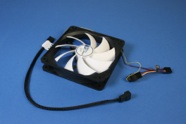
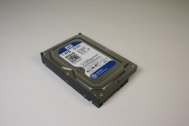
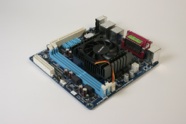
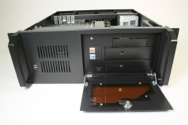
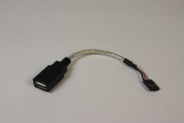
This article provides some information about the construction of a computer for CNC. This can take several different forms, from a simple setup with a single hard drive to a more complex configuration with removable drives.
Let’s be clear, though. The motherboard I chose (details below) has a built-in parallel port, but that will not be much use under Windows 7. It’s fine for XP and for running LinuxCNC, but won’t work under Windows 7. That’s a Windows 7 issue, and SmoothStepper or one of the add-on parallel port cards will be required.
Here’s the parts list for a couple of the computers I built: